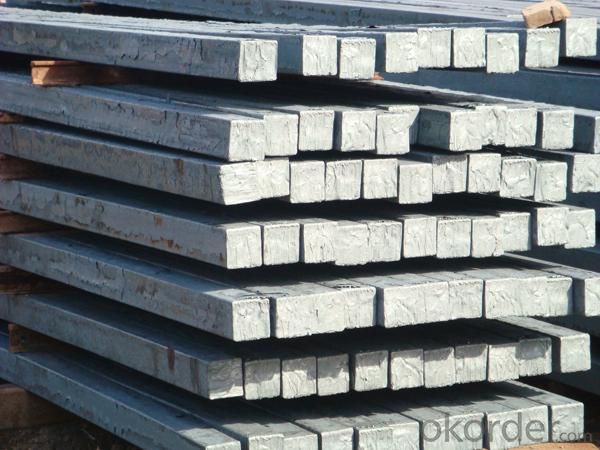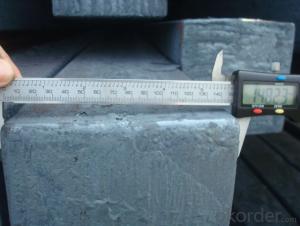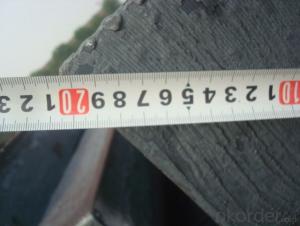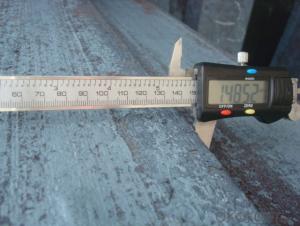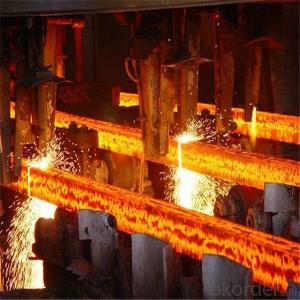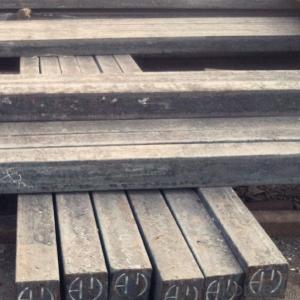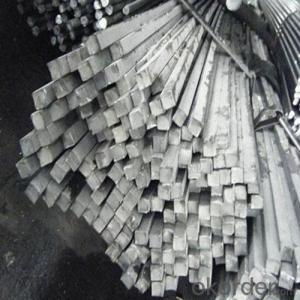Square Steel Billet, Square Bar with High Quality
- Loading Port:
- China main port
- Payment Terms:
- TT or LC
- Min Order Qty:
- 25000 m.t.
- Supply Capability:
- 35000 m.t./month
OKorder Service Pledge
OKorder Financial Service
You Might Also Like
Product Description of Square Steel Billet, Square Bar with High Quality:
square steel billet
1.3SP, 5SP
2.terms of payment: L/C at sight
3.size: 120*120mm
4.length: 5.8~12m
Specifications of Square Steel Billet, Square Bar with High Quality:
square steel billets
The following are the sizes of Billets available with Shyam Steel Industries Ltd.:
100 X 100
120x120
150 X 150
Physical Properties:
Description
As per IS 2830
Shyam Billets
Bend (max.) 5 mm per meter >= 5 mm per meter
Carbon (max.) 3mm per meter >= 3 mm per meter
Length 3 mt - 13 mt 3 mt - 9 mt
Chemical Properties:
Ladle Analysis:
Designation
Carbon
Manganese
C15 0.12-0.18 0.30-0.60
C18 0.15-0.21 0.30-0.60
C20 0.17-0.23 0.30-0.60
C15 MMn 0.12-0.18 0.60-1.00
C18 MMn 0.15-0.21 0.60-1.00
C20 MMn 0.17-0.23 0.60-1.00
C15 HMn 0.12-0.18 1.00-1.50
C18 HMn 0.15-0.21 1.00-1.50
C20 HMn
0.17-0.23 1.00-1.50
Production of Square Steel Billet, Square Bar with High Quality:
Billets of different designations are manufactured in three different grades namely A, B, C having sulphur, phosphorous content (on ladle analysis) and carbon equivalent as follows:
Chemical Analysis:
Grade Sulphur Phosphorous Carbon Equivalent (CE)1
Max Max Max
A 0.05 0.05 0.42
B 0.045 0.045 0.41
C 0.04 0.04 0.39
FAQ:
Q1: Why buy Materials & Equipment from OKorder.com?
A1: All products offered byOKorder.com are carefully selected from China's most reliable manufacturing enterprises. Through its ISO certifications, OKorder.com adheres to the highest standards and a commitment to supply chain safety and customer satisfaction.
Q2: How do we guarantee the quality of our products?
A2: We have established an advanced quality management system which conducts strict quality tests at every step, from raw materials to the final product. At the same time, we provide extensive follow-up service assurances as required.
Q3: How soon can we receive the product after purchase?
A3: Within three days of placing an order, we will begin production. The specific shipping date is dependent upon international and government factors, but is typically 7 to 10 workdays.
Images:


- Q: Are steel billets used in the production of household goods?
- Typically, steel billets find their purpose in a range of industries, like construction, automotive, and manufacturing, rather than in the production of household goods. These semi-finished products serve as raw materials and are commonly transformed through hot rolling into diverse shapes like bars, rods, or sheets. Only after undergoing further processing can they be fashioned into the desired household goods. Manufacturers of household goods usually prefer specific steel variants, such as stainless steel or carbon steel, which have been processed and shaped according to the specific requirements of the product.
- Q: What are the common defects in steel billets during hot rolling?
- Some common defects in steel billets during hot rolling include surface cracks, internal cracks, surface scales, segregation, and surface defects such as pits, scars, and scratches. These defects can affect the quality and integrity of the final product and may require further processing or rejection of the billets.
- Q: How do steel billets contribute to the overall thermal insulation of a structure?
- The overall thermal insulation of a structure is not directly influenced by steel billets. Instead, materials with low thermal conductivity, such as insulation boards or panels made from materials like fiberglass, foam, or mineral wool, are primarily used to achieve thermal insulation. On the other hand, steel billets are commonly utilized as a raw material in the construction industry for various purposes in the production of steel beams, columns, and other structural components. These components indirectly contribute to the thermal insulation of a structure when integrated correctly. For example, steel beams and columns play a crucial role in supporting and distributing the load of insulation materials, ensuring their effective performance. Moreover, steel components can be designed in a way that minimizes thermal bridging, which occurs when heat is transferred between materials with different thermal conductivities. By minimizing thermal bridging, steel components help maintain a consistent temperature throughout the structure and prevent heat loss or gain at these junctions. However, it is important to recognize that the primary function of steel billets in a structure is not thermal insulation. Instead, they provide structural stability, durability, and strength to the building. To achieve optimal thermal insulation, additional materials and construction techniques specifically designed for insulation purposes should be used alongside steel components.
- Q: What are the different methods of hardness testing for steel billets?
- There are several methods of hardness testing for steel billets, each offering different advantages and levels of accuracy. Some of the most common methods include: 1. Rockwell hardness testing: This is one of the most widely used methods and measures the depth of indentation caused by a specific load on a steel billet's surface. It provides a hardness value based on the depth of penetration, making it convenient and relatively quick to perform. 2. Brinell hardness testing: This method involves indenting a steel billet's surface with a spherical indenter under a specific load. The diameter of the resulting impression is measured to determine the hardness value. Brinell testing is especially useful for large billets or materials with a coarse microstructure. 3. Vickers hardness testing: Vickers testing uses a pyramidal diamond indenter to create an impression on the surface of a steel billet. The diagonal length of the impression is measured, and the hardness value is calculated based on the applied load. Vickers testing is suitable for a wide range of materials, including steel billets. 4. Knoop hardness testing: Similar to Vickers testing, Knoop hardness testing also uses a pyramidal diamond indenter. However, the indentation shape is elongated and narrower, allowing for measurements on smaller or thinner samples. This method is often used for precise and microhardness testing. 5. Leeb hardness testing: Leeb testing is a portable and non-destructive method that uses an impact device to measure the rebound hardness of a steel billet. The device strikes the surface with a small ball and measures the velocity of the rebound, which is then converted into a hardness value. This method is commonly used for on-site or in-field measurements. 6. Ultrasonic hardness testing: This method uses ultrasonic waves to measure the hardness of a steel billet. The waves are transmitted through the material, and the time taken for the waves to travel through the billet is measured. This data is then converted into a hardness value. Ultrasonic testing is non-destructive and suitable for large or thick billets. It is important to note that each hardness testing method has its own limitations and considerations. The choice of method will depend on factors such as the size, shape, and surface condition of the steel billet, as well as the desired accuracy and convenience of the testing process.
- Q: What are the different surface finishes available for stainless steel billets?
- There are several surface finishes available for stainless steel billets, depending on the desired aesthetic appearance and functional requirements. Some of the most common surface finishes for stainless steel billets include: 1. Mill Finish: This is the standard finish produced by the steel mill during the manufacturing process. It has a dull appearance with visible oxidation marks and can vary in smoothness. 2. Hot Rolled: This finish is achieved by heating the stainless steel billet and then rolling it through a series of rollers. It results in a rougher surface with visible scale and a characteristic orange peel texture. 3. Cold Rolled: This finish is obtained by subjecting the stainless steel billet to cold rolling, which reduces its thickness and improves its surface smoothness. It has a slightly reflective appearance and is often used for applications requiring a smooth finish. 4. Brushed Finish: Also known as satin finish, this surface finish is achieved by mechanically brushing the stainless steel billet with abrasive materials. It creates a consistent linear pattern, giving the steel a matte appearance. 5. Polished Finish: This finish involves polishing the stainless steel billet using abrasives to create a smooth and reflective surface. The level of polish can vary from a low-gloss satin finish to a mirror-like, highly reflective finish. 6. Bead Blasted Finish: In this finish, the stainless steel billet is bombarded with tiny glass or ceramic beads under high pressure, which creates a uniform matte texture. It is commonly used for architectural and decorative applications. 7. Electropolished Finish: This surface finish is achieved by immersing the stainless steel billet in an electrolyte bath and applying an electric current. It removes a thin layer of material, resulting in a smooth, reflective surface with improved corrosion resistance. These are just a few examples of the different surface finishes available for stainless steel billets. Each finish has its own unique characteristics and is chosen based on the specific requirements of the application, such as aesthetics, corrosion resistance, and ease of cleaning.
- Q: How do steel billets contribute to the manufacturing of industrial equipment?
- Steel billets are a crucial raw material in the manufacturing of industrial equipment as they serve as the starting point for various metal fabrication processes. These billets are heated, shaped, and further processed to create components such as gears, shafts, plates, and frames that form the backbone of industrial machinery. Their high strength, durability, and versatility make steel billets an essential ingredient in producing robust and reliable equipment for industries ranging from construction and mining to automotive and energy.
- Q: What are the specifications for steel billets used in the aerospace industry?
- The aerospace industry demands highly precise and stringent specifications for steel billets. These billets must adhere to specific standards to guarantee the safety and durability of aircraft components. Firstly, the steel utilized for aerospace billets must possess outstanding strength and toughness. It must exhibit a high tensile strength and the ability to withstand extreme forces and stresses encountered during flight. Additionally, the steel must demonstrate excellent fracture resistance to minimize the risk of catastrophic failure. Moreover, the steel billets must possess exceptional resistance to corrosion and oxidation. This is crucial as aircraft frequently operate in harsh environments, such as high altitudes and exposure to various chemicals. The steel should resist rust, pitting, and other forms of degradation that can compromise its structural integrity over time. Furthermore, the steel billets employed in aerospace applications must exhibit precise dimensional tolerances and uniformity. They should be manufactured according to exact specifications to ensure consistency in the production of aircraft components. This entails precise size, shape, and surface finish, which are vital for proper fitting and assembly. Regarding chemical composition, the steel used for aerospace billets may vary depending on the specific application and component being manufactured. However, it typically includes elements like carbon, manganese, chromium, nickel, and molybdenum. These alloying elements enhance the mechanical properties of the steel, such as hardness, toughness, and heat resistance. Additionally, the steel billets utilized in the aerospace industry undergo rigorous testing and quality control procedures. This includes non-destructive testing methods such as ultrasonic inspection, magnetic particle inspection, and dye penetrant inspection to identify any internal defects or discontinuities. In summary, the specifications for steel billets used in the aerospace industry encompass exceptional strength, toughness, corrosion resistance, dimensional accuracy, and precise chemical composition. These stringent requirements ensure the reliability and safety of aircraft components, enabling them to withstand the demanding conditions experienced during flight.
- Q: How are steel billets used in the manufacturing of industrial machinery parts?
- Steel billets are used in the manufacturing of industrial machinery parts as they serve as the raw material for shaping and forming various components such as gears, shafts, and frames. These billets are heated and then passed through a series of processes like forging, machining, and welding to create the desired shape and size required for the machinery part. The strength and durability of steel make it an ideal material for industrial machinery, ensuring reliable performance and longevity.
- Q: Billet market trend
- 3, Tangshan billet inventory declineIt is understood that in April, the Tangshan region began to decline in the stock of major steel warehouse, as of April 28th, Tangshan billet inventory at about 1 million 250 thousand tons, a drop of about half higher than the high point. But some vendors have revealed that some of the resources are being transferred from the warehouse to the traders. In fact, inventories are much larger than statistics, and the inventory of 1 million 250 thousand tons of steel is about 2.5 times that of the same period of last year.In addition, network analyst China industry insight believes the macroeconomic situation, the weakening of steel and steel industry more negative news of the credit crisis will be unfavorable to the billet market outlook. But considering the steel production has been at a loss, the billet has a certain resilience; and before the May Day holiday billet prices fell rapidly, it is possible to pull up the opportunity to play after the manufacturers in a certain way.
- Q: What are the different types of surface defects found in steel billets?
- There are several types of surface defects that can be found in steel billets. These defects can occur during the manufacturing process or due to external factors. Some of the common surface defects found in steel billets include: 1. Scale: Scale is a type of oxide layer that forms on the surface of the billet during the heating and cooling processes. It appears as a thin layer of rust-like material and can affect the quality and appearance of the steel. 2. Cracks: Cracks can occur due to improper cooling or excessive stress during the manufacturing process. These cracks can be either longitudinal or transverse and can weaken the structural integrity of the billet. 3. Pits: Pits are small depressions or cavities that can be found on the surface of the billet. They can occur due to the presence of impurities or as a result of corrosion. 4. Seam: A seam is a linear defect that can be found along the surface of the billet. It is caused by the improper joining of two sections of the billet during the manufacturing process. 5. Lamination: Lamination defects occur when there are layers or flakes of material that separate from the surface of the billet. This can be caused by improper rolling or an inadequate bonding between layers. 6. Inclusions: Inclusions are non-metallic particles or impurities that are trapped within the steel billet during the manufacturing process. These inclusions can affect the mechanical properties of the steel and reduce its overall quality. 7. Decarburization: Decarburization is a surface defect where the carbon content of the steel is reduced, leading to a softer and weaker surface layer. This can occur due to improper heating or cooling processes. It is important to detect and address these surface defects in steel billets to ensure the quality and performance of the final steel products. Various inspection methods and quality control measures are employed during the manufacturing process to minimize the occurrence of these defects.
Send your message to us
Square Steel Billet, Square Bar with High Quality
- Loading Port:
- China main port
- Payment Terms:
- TT or LC
- Min Order Qty:
- 25000 m.t.
- Supply Capability:
- 35000 m.t./month
OKorder Service Pledge
OKorder Financial Service
Similar products
Hot products
Hot Searches
Related keywords



